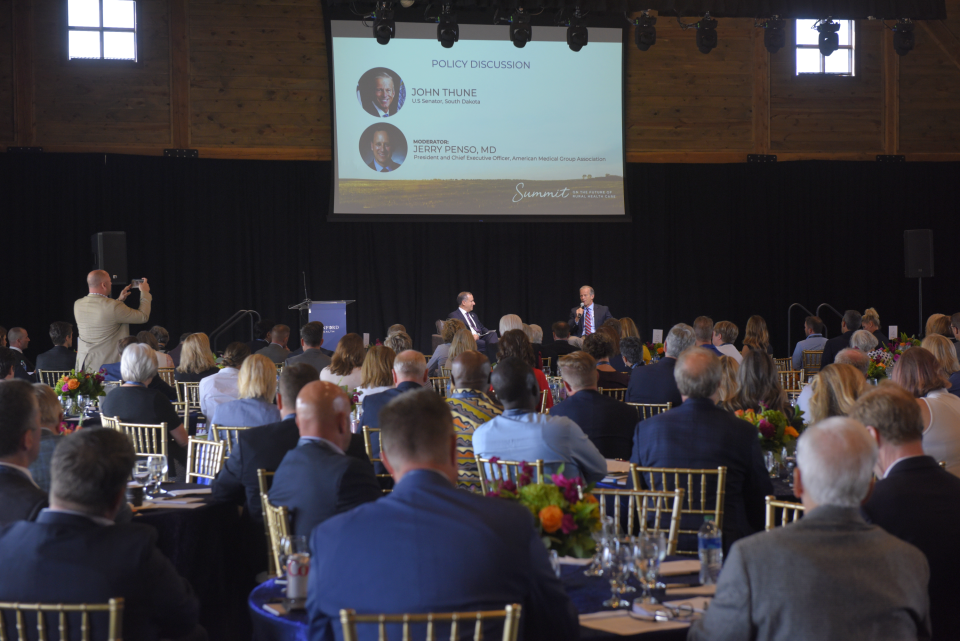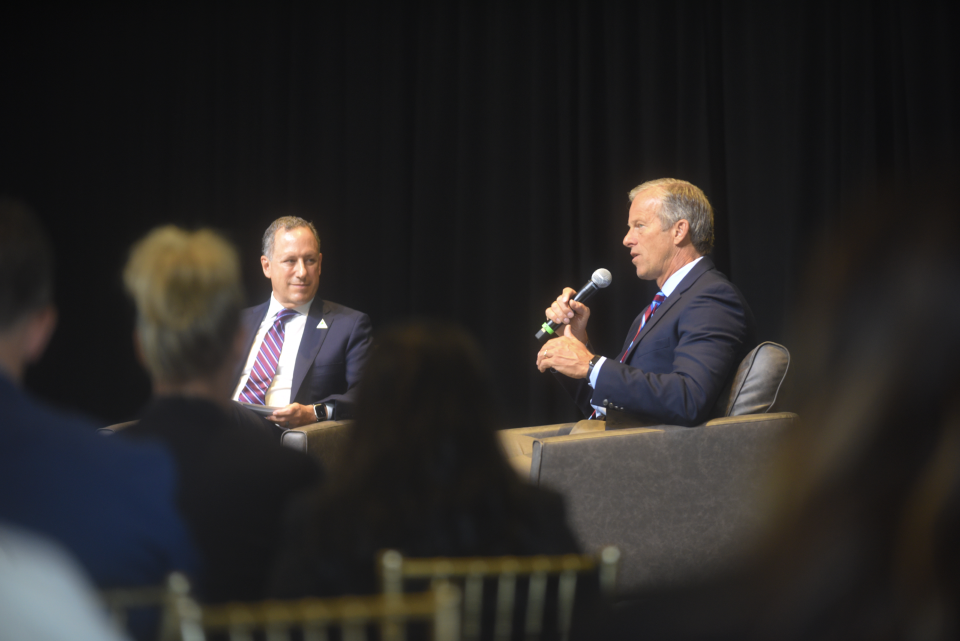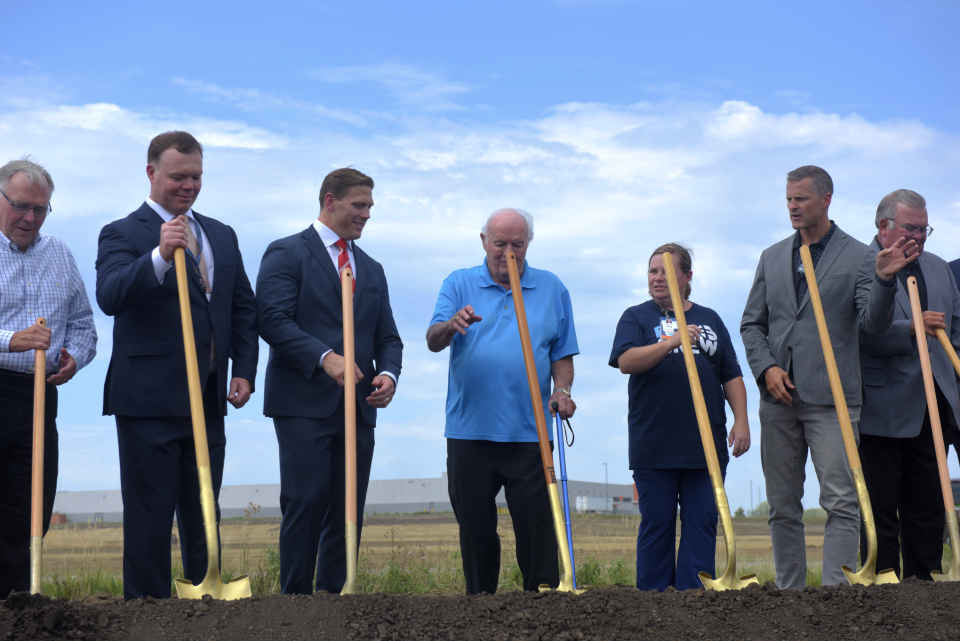Sanford Virtual Care Center groundbreaking underscores need for rural health investment
Correction: Brad Schipper, president of virtual care for Sanford Health, was misidentified in an earlier version of this story.
At the Sanford Event Barn, where nationally renowned healthcare leaders and executives networked under classy chandeliers, juxtaposed by farm-style furniture that had been upholstered with silk-white fabric and golden legs, the region's healthcare giant led a dialogue on healthcare in rural America.
Sanford Health hosted a national Summit on the Future of Rural Health Care on Tuesday, where a series of discussions centered around the issue of rural health and the industry's on-going effort to close the gaps of accessibility took place. The summit was the first of its kind for the organization.
These fireside chats and solution-oriented brainstorms came before Sanford turned the dirt on the future site of the Virtual Care Center during a groundbreaking ceremony that same day. But the facility, which received a $350 million donation from the health organization's eponymous investor, T. Denny Sanford, underscored the work that remains for most of South Dakota and the rest of rural America to become better connected to accessible healthcare providers.

Sanford Health's new center now positions the healthcare system as fresh face in the region's telemedicine coverage, after Avera Health launched their own eCare branch in '90s to similarly provide rural coverage in the Upper Midwest. Aquiline Capital Partners acquired and renamed the virtual department as Avel eCare in July 2021, which continues to be provide business-to-business services in the region, including with Avera.
"I think Sanford is about accessibly. If you're looking at what they're trying to accomplish and how they're shedding light on telemedicine, that's essential," Avel CEO Doug Duskin told the Argus Leader on Wednesday. "I can congratulate them on keeping the light on telemedicine and evolving their products."

A major investment in the future
The Sanford Virtual Care Center, which will be near the Sanford Sports Complex, is now in the construction phase and is anticipated to open in 2024.
While representatives for Sanford said it has not been determined how many new or existing staff will occupy this space, Bill Gassen, CEO and president of Sanford Health, said during a speech the 60,000-square-foot facility will feature "dedicated clinician workspaces equipped with the latest telemedicine technology to offer a variety of service lines, including on-demand urgent care, behavioral health care and primary care."
"Right now, we know many of the challenges we face in rural America are the retention and the recruitment of physicians," Gassen told the Argus Leader. "It's very difficult — not because people don't want to be in rural communities, but it can be very challenging to be the only physician in a community on-call, 365 days out of the year."
Duskin said the Sanford's new center is an attempt to fill the holes that can arise when rural hospitals become short-staffed. It's a need, he said, that existed before the pandemic, but went to drastic extremes during its peak.
"If you look at some of our rural hospitals, there may be one or two ER doctors in the facility. If they want to take a vacation … what ends up happening is that the availability of these doctors isn't there, so they fill them with nurses," Duskin said. "I think the telemedicine avenue ensures that staffing and those nurses get the support so that work life balance can exist in these rural communities."
More: Sanford partners with Dandelion Health to create clinical AI products
A press release for the organization said the site will expand its 250,000-square-mile footprint across the Upper Midwest, along with five satellite offices in underserved rural areas.
Gassen pointed to Sanford Health's growing application of telemedicine, which was jumpstarted by the provider's launch of its Covid-19 home monitoring program in spring 2020, as part of their shift to virtual care.
"We saw a drastic uptick in the adoption of telemedicine, both in our patients and by our physicians, our nurses and all of our care teams," he said. "What we really want to do is make sure we don't lose the positive momentum of that."
Brad Schipper, president of virtual care for Sanford Health, called the center's creation of the center a "once-in-a-lifetime" opportunity. He said the largely telemedicine facility represents a major investment in rural healthcare by Sanford Health.
"This will be the way we deliver healthcare in the future. It won't replace all the traditional avenues that we're used to, but it will sure become much more mainstream," Schipper said.

"If you have to take a entire day off from work, if you have to travel hundreds of miles to go see a physician, it's very disruptive," Gassen added. "By allowing them to interface with us from their homes or maybe from a remote clinic that we'll have set-up in these communities, we know we're doing a better job of meeting their needs."
T. Denny Sanford attended the groundbreaking as well, where Gassen and other Sanford executives thanked their organization's namesake for the donation that facilitated the creation of the center as well as the work of nurses and physicians.
The road to better rural healthcare
But the conversation at the summit and groundbreaking wasn't limited to the region. Hours before striking earth to gold shovel, Sanford Health executives and those from other states also convened to address the issue of rural healthcare from a national perspective as well.
Dr. Michael Suk, a chair on the Musculoskeletal Institute at University of Connecticut Health, was one of the panelists invited to speak. He said rural areas face many of the same issues that affect people seeking medical care in urban areas — lack of transportation, for instance — but the people are disproportionately affected.
These issues extend to the care rural facilities may struggle to provide. According to the Bipartisan Policy Center, more than one in five rural hospitals face three or more financial risk factors, such as negative profits and loss of assets.

U.S. Sen. John Thune, one of the speakers at the barn roundtable, told the Argus Leader in a phone interview that investments in rural health are needed to provide stability for the industry that saw a spike in use — and emergency funding — during the pandemic.
More: Stop Animal Exploitation Now asks for investigation into Sanford Health scientist
Part of this includes expanding rural broadband across the state through legislation: Thune's Reforming Broadband Connectivity Act, which would fund the Federal Communications Commission’s Universal Service Fund and thereby generally expand access to broadband, and his STREAMLINE Small Cell Deployment Act, which would facilitate in the deployment of 5G technology nationwide, have yet to go beyond being introduced to Congress.
Dr. Geeta Nayyar, chief medical officer of Salesforce, a software company based in California, said the future of technology and its applications to rural healthcare "looks bright." But Nayyar added the digital infrastructure of the health industry has traditionally relied on "piecemealing" old technology to its new systems when it should be the other way around.

Nayyar also said there is a lack of local physicians in the industry, which is a key issue in serving minority communities. She said brown and Black populations are more distrustful of health systems, especially in urban facilities, where patients tend to have a harder time building a relationship with their doctors.
Dominik Dausch is the agriculture and environment reporter for the Argus Leader and editor of Farm Forum. Follow him on Twitter and Facebook @DomDNP and send news tips to ddausch@gannett.com.
This article originally appeared on Sioux Falls Argus Leader: Sanford Health takes next steps in telemedicine, virtual care

